Reptiles of the World
Photo Workshop and Shoot
Trip Report



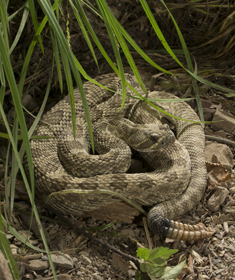
Treefrog silhouette, Giant Marine Toad, Eyelash Viper, Prairie Rattlesnake
Our Reptiles of the World Photo Workshop and Shoot is one of our oldest offerings, one we started in the early 1990's but one we're always excited about offering and one that we are continually improving. Until recently we did not include 'workshop' in our title, but we've added that phrase for two reasons. One, our participants learn how to use electronic flash for effective, dramatic lighting, and how to set up extremely realistic, natural sets that complement our subjects. Our sets always reflect the habitats where our subjects live, where they may bask in the sun, or hide in a bush, or stalk along a long-stemmed reed.
Our 2014 Brochure is Posted!
 These sets are one of the ways our shoot/workshop is unique and completely different from anything else offered. The few reptile or treefrog shoots offered elsewhere typically have the participants using their own flash equipment, usually on camera, for rather uninspired and respective lighting, on subjects placed in extremely generic set ups. Nonetheless, these shoots are described as workshops, and appear on search engines quickly, whereas our shoot is buried deep within the web via these same search engine titles. After comparing our results with others we decided that adding the word, workshop, was accurate and necessary, and should expose more people to the opportunities this shoot presents.
These sets are one of the ways our shoot/workshop is unique and completely different from anything else offered. The few reptile or treefrog shoots offered elsewhere typically have the participants using their own flash equipment, usually on camera, for rather uninspired and respective lighting, on subjects placed in extremely generic set ups. Nonetheless, these shoots are described as workshops, and appear on search engines quickly, whereas our shoot is buried deep within the web via these same search engine titles. After comparing our results with others we decided that adding the word, workshop, was accurate and necessary, and should expose more people to the opportunities this shoot presents.
This year we had nearly 100 subjects to photograph, although only 70 to 80 subjects were shot in each of our two shoots. The reason we didn't get through all of our subjects is we are not trying to do an assembly line of shooting, but instead to make great sets and accurate, interesting lighting, so that each image is unique, attractive, and not repetitive. As you'll see in the following collection of images I think we succeeded in this.
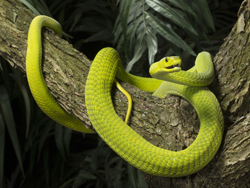
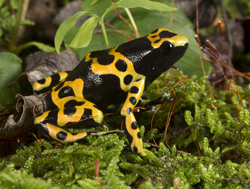


Green Mamba, Bumble-Bee Dart Frog, Lined Leaf-tailed Gecko, Red-eared Slider
As we have had for our previous years, the different subjects we photographed came from three different sources to provided us with a variety of incredible images. Special thanks is extended to Chad Peeling from Clyde Peeling's Reptiland, an accredited zoo that specializes in displaying reptiles and amphibians, and my friends Gary Lee who supplied most of our venomous snakes, and especially to Dave Northcott, who drove in from California with a truck-full of reptiles, including treefrogs, geckos, aquatic turtles, and many colorful snakes and lizards.




Red Spitting Cobra, Black Pakistani Cobra,
yellow phase Timber Rattlesnake, Mangrove Snake
One of the most exciting features of the shoot are the venomous snakes we photograph. Expertly handled, the shoot is perfectly safe, although there certainly is an adrenaline rush when photographing a hooding cobra just a few feet away. This year we photographed three species of cobra and two beautiful species of mamba, the East African Green and West African Green. Both are arboreal species and are chameleon eaters, despite the fact that their venom is quite toxic.
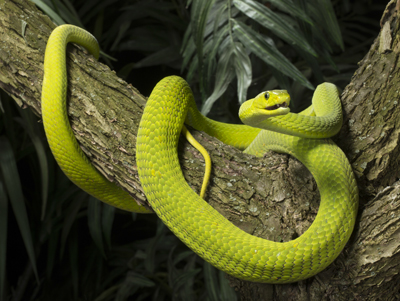



East African Green and Western African Green Mambas
 The largest, longest venomous snake in the world is the King Cobra, and an adult can grow to 18 feet. King Cobras can rear or raise their forequarters almost a third of their body length, so it is conceivable, in southern Asia, to encounter one upon a narrow bamboo trail and to have the snake rear up, towering above a villager or child! We shot a newly hatched King Cobra, sporting the vivid black and yellow pattern of a juvenile, a pattern that will be lost as the snake grows to maturity and becomes a rather nondescript yellowish-tan giant.
The largest, longest venomous snake in the world is the King Cobra, and an adult can grow to 18 feet. King Cobras can rear or raise their forequarters almost a third of their body length, so it is conceivable, in southern Asia, to encounter one upon a narrow bamboo trail and to have the snake rear up, towering above a villager or child! We shot a newly hatched King Cobra, sporting the vivid black and yellow pattern of a juvenile, a pattern that will be lost as the snake grows to maturity and becomes a rather nondescript yellowish-tan giant.
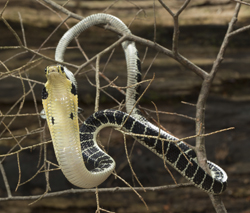
Each day we filmed a different habitat theme, from arboreal jungle to wetland swamp. Subjects appropriate for each habitat were shot in sequence, with whatever required changes in props to make each set different and authentic. Below is a sampling of some of our subjects and sets for arboreal herptiles.


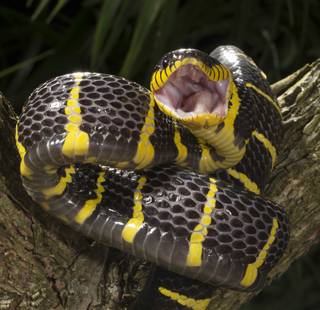
Three arboreal snakes, Eyelash Viper, Green Tree Python, and Mangrove Snake.




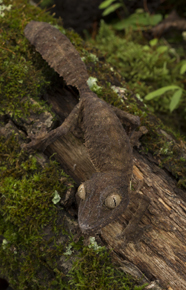
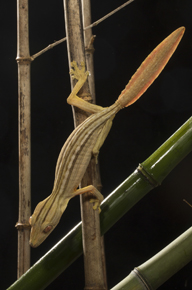

Several different species of arboreal gecko, including
Giant Leaf-tailed, New Caledonia Giant, Lined Leaf-tailed, Crested, Mossy Leaf-tailed, and Henkel's Leaf-tailed Geckos.





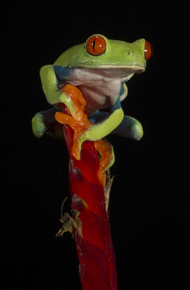
Eared Treefrog, Amazon Milk Frog, Gliding Treefrog,
African Clown Reed Frog, Red-eyed Treefrog
One of the favorite subjects are the most unusual Chameleons, famous for their ability to change color. Chameleons, however, have other unique adaptations. Their eyes are bulbous and can independently rotate, allowing a chameleon to look forward and backwards at the same time. Their toes are fused, creating a 2/3 clamp for a secure grip, and their tail increases their stability as it is prehensile, one of only a few lizards with this feature.




Crested or Sailfin, Panther, and Jackson's Chameleons
When we first initiated this photo workshop and shoot we concentrated on venomous reptiles, and although over the years we've expanded to beautiful and interesting nonvenomous species of all types, we still offered a nice assortment of rattlesnakes, copperheads, and other venomous species. The following is a small sample.


Broad-banded Copperhead, Black-tailed Rattlesnake

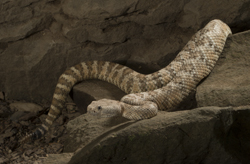
Gaboon Viper, Speckled Rattlesnake


Southern Copperhead, Timber Rattlesnake


Black-tailed Rattlesnake, Western Diamondback Rattlesnake
Wetland habitats are particularly challenging to make in an indoor studio, but the effort was worth it with the several species filmed over, around, or in water. We were particularly excited to have a Caiman Lizard, a crocodilian-looking lizard from the Pantanal of Brazil. I've only seen one of these lizards in the wild, and that was a road-kill, so examining a live lizard up close was a real thrill. These lizards eat snails in the wild, and consequently have huge, powerful jaws. Fortunately our lizard was tame and didn't try to bite.




Caiman Lizard, Chinese Water Dragon, Dwarf Crocodile, African Bullfrog
Our desert and grassland habitats were diverse, including rock-dwelling diurnal and crevice-seeking nocturnal species. We had three species of Tarantula, too, which were a real treat for one of our shoots.


Spiny-tailed Agama, Collared Lizard


TwoTarantulas, Rose Hair and Baboon


Malaysian Cat Gecko, Chinese Cave Gecko

Ornate Uromastyx Lizard


Yellow Uromastyx Lizard, Leopard Gecko
Rather than continue with a descriptive text, the following mini-portfolios will give you a great idea of what we shot in the two shoots. We had six participants per shoot, with two of these people staying for both shoots and consequently getting better coverage. There were different subjects on both shoots, although about 60% of the species were repeated, but always with a different habitat set-up. The images below will illustrate:











A variety of frogs














A variety of Lizards
All of our subjects were illuminated by our Einstein electronic flashes, which were supported by Manfrotto Magic Arms mounted upon auto light poles. For some sets we used as many as a dozen Manfrotto arms, super clamps, and supports, but the results, I hope, provided a 'wild' and realistic look that was extremely authentic and true to the reptile or amphibian's natural habitat.
We will be offering at least two Reptiles of the World Photo Workshop and Shoot in 2014, with six participants per shoot. We do not have the dates set as of July 9, 2013, but the dates will be either in late June or early July, or covering that period. If you are interested in joining us next year, please contact our office ASAP to get on our first contact list to allow us to notify you when the dates are confirmed.
The links below will give you an idea of the variety of subjects we have filmed on some of our previous shoots as well. Check out our portfolio or that of Rich Miller, or our previous postings, all linked below.
Check out my portfolio of many of the subjects we did on shoot.
Check out the posted images of one of our participants, Rich Miller, for more views from this exciting shoot!
Contact our Office to REGISTER for this Photo Shoot which we will hold in 2014.
View a Reptiles of the World Portfolio
that illustrates subjects from previous shoots.
Return to HomePage or to photo tours general information.
Contact us by e-mail:info@hoothollow.com
Office Phone: 717 543-6423
Or FAX us at: (717) 543-5342.
Return to HomePage
Reptiles of the World
Photo Workshop and Shoot
Trip Report




Treefrog silhouette, Giant Marine Toad, Eyelash Viper, Prairie Rattlesnake
Our Reptiles of the World Photo Workshop and Shoot is one of our oldest offerings, one we started in the early 1990's but one we're always excited about offering and one that we are continually improving. Until recently we did not include 'workshop' in our title, but we've added that phrase for two reasons. One, our participants learn how to use electronic flash for effective, dramatic lighting, and how to set up extremely realistic, natural sets that complement our subjects. Our sets always reflect the habitats where our subjects live, where they may bask in the sun, or hide in a bush, or stalk along a long-stemmed reed.
Our 2014 Brochure is Posted!
 These sets are one of the ways our shoot/workshop is unique and completely different from anything else offered. The few reptile or treefrog shoots offered elsewhere typically have the participants using their own flash equipment, usually on camera, for rather uninspired and respective lighting, on subjects placed in extremely generic set ups. Nonetheless, these shoots are described as workshops, and appear on search engines quickly, whereas our shoot is buried deep within the web via these same search engine titles. After comparing our results with others we decided that adding the word, workshop, was accurate and necessary, and should expose more people to the opportunities this shoot presents.
These sets are one of the ways our shoot/workshop is unique and completely different from anything else offered. The few reptile or treefrog shoots offered elsewhere typically have the participants using their own flash equipment, usually on camera, for rather uninspired and respective lighting, on subjects placed in extremely generic set ups. Nonetheless, these shoots are described as workshops, and appear on search engines quickly, whereas our shoot is buried deep within the web via these same search engine titles. After comparing our results with others we decided that adding the word, workshop, was accurate and necessary, and should expose more people to the opportunities this shoot presents.
This year we had nearly 100 subjects to photograph, although only 70 to 80 subjects were shot in each of our two shoots. The reason we didn't get through all of our subjects is we are not trying to do an assembly line of shooting, but instead to make great sets and accurate, interesting lighting, so that each image is unique, attractive, and not repetitive. As you'll see in the following collection of images I think we succeeded in this.




Green Mamba, Bumble-Bee Dart Frog, Lined Leaf-tailed Gecko, Red-eared Slider
As we have had for our previous years, the different subjects we photographed came from three different sources to provided us with a variety of incredible images. Special thanks is extended to Chad Peeling from Clyde Peeling's Reptiland, an accredited zoo that specializes in displaying reptiles and amphibians, and my friends Gary Lee who supplied most of our venomous snakes, and especially to Dave Northcott, who drove in from California with a truck-full of reptiles, including treefrogs, geckos, aquatic turtles, and many colorful snakes and lizards.




Red Spitting Cobra, Black Pakistani Cobra,
yellow phase Timber Rattlesnake, Mangrove Snake
One of the most exciting features of the shoot are the venomous snakes we photograph. Expertly handled, the shoot is perfectly safe, although there certainly is an adrenaline rush when photographing a hooding cobra just a few feet away. This year we photographed three species of cobra and two beautiful species of mamba, the East African Green and West African Green. Both are arboreal species and are chameleon eaters, despite the fact that their venom is quite toxic.




East African Green and Western African Green Mambas
 The largest, longest venomous snake in the world is the King Cobra, and an adult can grow to 18 feet. King Cobras can rear or raise their forequarters almost a third of their body length, so it is conceivable, in southern Asia, to encounter one upon a narrow bamboo trail and to have the snake rear up, towering above a villager or child! We shot a newly hatched King Cobra, sporting the vivid black and yellow pattern of a juvenile, a pattern that will be lost as the snake grows to maturity and becomes a rather nondescript yellowish-tan giant.
The largest, longest venomous snake in the world is the King Cobra, and an adult can grow to 18 feet. King Cobras can rear or raise their forequarters almost a third of their body length, so it is conceivable, in southern Asia, to encounter one upon a narrow bamboo trail and to have the snake rear up, towering above a villager or child! We shot a newly hatched King Cobra, sporting the vivid black and yellow pattern of a juvenile, a pattern that will be lost as the snake grows to maturity and becomes a rather nondescript yellowish-tan giant.

Each day we filmed a different habitat theme, from arboreal jungle to wetland swamp. Subjects appropriate for each habitat were shot in sequence, with whatever required changes in props to make each set different and authentic. Below is a sampling of some of our subjects and sets for arboreal herptiles.



Three arboreal snakes, Eyelash Viper, Green Tree Python, and Mangrove Snake.







Several different species of arboreal gecko, including
Giant Leaf-tailed, New Caledonia Giant, Lined Leaf-tailed, Crested, Mossy Leaf-tailed, and Henkel's Leaf-tailed Geckos.






Eared Treefrog, Amazon Milk Frog, Gliding Treefrog,
African Clown Reed Frog, Red-eyed Treefrog
One of the favorite subjects are the most unusual Chameleons, famous for their ability to change color. Chameleons, however, have other unique adaptations. Their eyes are bulbous and can independently rotate, allowing a chameleon to look forward and backwards at the same time. Their toes are fused, creating a 2/3 clamp for a secure grip, and their tail increases their stability as it is prehensile, one of only a few lizards with this feature.




Crested or Sailfin, Panther, and Jackson's Chameleons
When we first initiated this photo workshop and shoot we concentrated on venomous reptiles, and although over the years we've expanded to beautiful and interesting nonvenomous species of all types, we still offered a nice assortment of rattlesnakes, copperheads, and other venomous species. The following is a small sample.


Broad-banded Copperhead, Black-tailed Rattlesnake


Gaboon Viper, Speckled Rattlesnake


Southern Copperhead, Timber Rattlesnake


Black-tailed Rattlesnake, Western Diamondback Rattlesnake
Wetland habitats are particularly challenging to make in an indoor studio, but the effort was worth it with the several species filmed over, around, or in water. We were particularly excited to have a Caiman Lizard, a crocodilian-looking lizard from the Pantanal of Brazil. I've only seen one of these lizards in the wild, and that was a road-kill, so examining a live lizard up close was a real thrill. These lizards eat snails in the wild, and consequently have huge, powerful jaws. Fortunately our lizard was tame and didn't try to bite.




Caiman Lizard, Chinese Water Dragon, Dwarf Crocodile, African Bullfrog
Our desert and grassland habitats were diverse, including rock-dwelling diurnal and crevice-seeking nocturnal species. We had three species of Tarantula, too, which were a real treat for one of our shoots.


Spiny-tailed Agama, Collared Lizard


TwoTarantulas, Rose Hair and Baboon


Malaysian Cat Gecko, Chinese Cave Gecko

Ornate Uromastyx Lizard


Yellow Uromastyx Lizard, Leopard Gecko
Rather than continue with a descriptive text, the following mini-portfolios will give you a great idea of what we shot in the two shoots. We had six participants per shoot, with two of these people staying for both shoots and consequently getting better coverage. There were different subjects on both shoots, although about 60% of the species were repeated, but always with a different habitat set-up. The images below will illustrate:











A variety of frogs














A variety of Lizards
All of our subjects were illuminated by our Einstein electronic flashes, which were supported by Manfrotto Magic Arms mounted upon auto light poles. For some sets we used as many as a dozen Manfrotto arms, super clamps, and supports, but the results, I hope, provided a 'wild' and realistic look that was extremely authentic and true to the reptile or amphibian's natural habitat.
We will be offering at least two Reptiles of the World Photo Workshop and Shoot in 2014, with six participants per shoot. We do not have the dates set as of July 9, 2013, but the dates will be either in late June or early July, or covering that period. If you are interested in joining us next year, please contact our office ASAP to get on our first contact list to allow us to notify you when the dates are confirmed.
The links below will give you an idea of the variety of subjects we have filmed on some of our previous shoots as well. Check out our portfolio or that of Rich Miller, or our previous postings, all linked below.
Check out my portfolio of many of the subjects we did on shoot.
Check out the posted images of one of our participants, Rich Miller, for more views from this exciting shoot!
Contact our Office to REGISTER for this Photo Shoot which we will hold in 2014.
View a Reptiles of the World Portfolio
that illustrates subjects from previous shoots.
Return to HomePage or to photo tours general information.
Contact us by e-mail:info@hoothollow.com
Office Phone: 717 543-6423
Or FAX us at: (717) 543-5342.
Return to HomePage
Reptiles of the World
Photo Workshop and Shoot
Trip Report




Treefrog silhouette, Giant Marine Toad, Eyelash Viper, Prairie Rattlesnake
Our Reptiles of the World Photo Workshop and Shoot is one of our oldest offerings, one we started in the early 1990's but one we're always excited about offering and one that we are continually improving. Until recently we did not include 'workshop' in our title, but we've added that phrase for two reasons. One, our participants learn how to use electronic flash for effective, dramatic lighting, and how to set up extremely realistic, natural sets that complement our subjects. Our sets always reflect the habitats where our subjects live, where they may bask in the sun, or hide in a bush, or stalk along a long-stemmed reed.
Our 2014 Brochure is Posted!
 These sets are one of the ways our shoot/workshop is unique and completely different from anything else offered. The few reptile or treefrog shoots offered elsewhere typically have the participants using their own flash equipment, usually on camera, for rather uninspired and respective lighting, on subjects placed in extremely generic set ups. Nonetheless, these shoots are described as workshops, and appear on search engines quickly, whereas our shoot is buried deep within the web via these same search engine titles. After comparing our results with others we decided that adding the word, workshop, was accurate and necessary, and should expose more people to the opportunities this shoot presents.
These sets are one of the ways our shoot/workshop is unique and completely different from anything else offered. The few reptile or treefrog shoots offered elsewhere typically have the participants using their own flash equipment, usually on camera, for rather uninspired and respective lighting, on subjects placed in extremely generic set ups. Nonetheless, these shoots are described as workshops, and appear on search engines quickly, whereas our shoot is buried deep within the web via these same search engine titles. After comparing our results with others we decided that adding the word, workshop, was accurate and necessary, and should expose more people to the opportunities this shoot presents.
This year we had nearly 100 subjects to photograph, although only 70 to 80 subjects were shot in each of our two shoots. The reason we didn't get through all of our subjects is we are not trying to do an assembly line of shooting, but instead to make great sets and accurate, interesting lighting, so that each image is unique, attractive, and not repetitive. As you'll see in the following collection of images I think we succeeded in this.




Green Mamba, Bumble-Bee Dart Frog, Lined Leaf-tailed Gecko, Red-eared Slider
As we have had for our previous years, the different subjects we photographed came from three different sources to provided us with a variety of incredible images. Special thanks is extended to Chad Peeling from Clyde Peeling's Reptiland, an accredited zoo that specializes in displaying reptiles and amphibians, and my friends Gary Lee who supplied most of our venomous snakes, and especially to Dave Northcott, who drove in from California with a truck-full of reptiles, including treefrogs, geckos, aquatic turtles, and many colorful snakes and lizards.




Red Spitting Cobra, Black Pakistani Cobra,
yellow phase Timber Rattlesnake, Mangrove Snake
One of the most exciting features of the shoot are the venomous snakes we photograph. Expertly handled, the shoot is perfectly safe, although there certainly is an adrenaline rush when photographing a hooding cobra just a few feet away. This year we photographed three species of cobra and two beautiful species of mamba, the East African Green and West African Green. Both are arboreal species and are chameleon eaters, despite the fact that their venom is quite toxic.




East African Green and Western African Green Mambas
 The largest, longest venomous snake in the world is the King Cobra, and an adult can grow to 18 feet. King Cobras can rear or raise their forequarters almost a third of their body length, so it is conceivable, in southern Asia, to encounter one upon a narrow bamboo trail and to have the snake rear up, towering above a villager or child! We shot a newly hatched King Cobra, sporting the vivid black and yellow pattern of a juvenile, a pattern that will be lost as the snake grows to maturity and becomes a rather nondescript yellowish-tan giant.
The largest, longest venomous snake in the world is the King Cobra, and an adult can grow to 18 feet. King Cobras can rear or raise their forequarters almost a third of their body length, so it is conceivable, in southern Asia, to encounter one upon a narrow bamboo trail and to have the snake rear up, towering above a villager or child! We shot a newly hatched King Cobra, sporting the vivid black and yellow pattern of a juvenile, a pattern that will be lost as the snake grows to maturity and becomes a rather nondescript yellowish-tan giant.

Each day we filmed a different habitat theme, from arboreal jungle to wetland swamp. Subjects appropriate for each habitat were shot in sequence, with whatever required changes in props to make each set different and authentic. Below is a sampling of some of our subjects and sets for arboreal herptiles.



Three arboreal snakes, Eyelash Viper, Green Tree Python, and Mangrove Snake.







Several different species of arboreal gecko, including
Giant Leaf-tailed, New Caledonia Giant, Lined Leaf-tailed, Crested, Mossy Leaf-tailed, and Henkel's Leaf-tailed Geckos.






Eared Treefrog, Amazon Milk Frog, Gliding Treefrog,
African Clown Reed Frog, Red-eyed Treefrog
One of the favorite subjects are the most unusual Chameleons, famous for their ability to change color. Chameleons, however, have other unique adaptations. Their eyes are bulbous and can independently rotate, allowing a chameleon to look forward and backwards at the same time. Their toes are fused, creating a 2/3 clamp for a secure grip, and their tail increases their stability as it is prehensile, one of only a few lizards with this feature.




Crested or Sailfin, Panther, and Jackson's Chameleons
When we first initiated this photo workshop and shoot we concentrated on venomous reptiles, and although over the years we've expanded to beautiful and interesting nonvenomous species of all types, we still offered a nice assortment of rattlesnakes, copperheads, and other venomous species. The following is a small sample.


Broad-banded Copperhead, Black-tailed Rattlesnake


Gaboon Viper, Speckled Rattlesnake


Southern Copperhead, Timber Rattlesnake


Black-tailed Rattlesnake, Western Diamondback Rattlesnake
Wetland habitats are particularly challenging to make in an indoor studio, but the effort was worth it with the several species filmed over, around, or in water. We were particularly excited to have a Caiman Lizard, a crocodilian-looking lizard from the Pantanal of Brazil. I've only seen one of these lizards in the wild, and that was a road-kill, so examining a live lizard up close was a real thrill. These lizards eat snails in the wild, and consequently have huge, powerful jaws. Fortunately our lizard was tame and didn't try to bite.




Caiman Lizard, Chinese Water Dragon, Dwarf Crocodile, African Bullfrog
Our desert and grassland habitats were diverse, including rock-dwelling diurnal and crevice-seeking nocturnal species. We had three species of Tarantula, too, which were a real treat for one of our shoots.


Spiny-tailed Agama, Collared Lizard


TwoTarantulas, Rose Hair and Baboon


Malaysian Cat Gecko, Chinese Cave Gecko

Ornate Uromastyx Lizard


Yellow Uromastyx Lizard, Leopard Gecko
Rather than continue with a descriptive text, the following mini-portfolios will give you a great idea of what we shot in the two shoots. We had six participants per shoot, with two of these people staying for both shoots and consequently getting better coverage. There were different subjects on both shoots, although about 60% of the species were repeated, but always with a different habitat set-up. The images below will illustrate:











A variety of frogs














A variety of Lizards
All of our subjects were illuminated by our Einstein electronic flashes, which were supported by Manfrotto Magic Arms mounted upon auto light poles. For some sets we used as many as a dozen Manfrotto arms, super clamps, and supports, but the results, I hope, provided a 'wild' and realistic look that was extremely authentic and true to the reptile or amphibian's natural habitat.
We will be offering at least two Reptiles of the World Photo Workshop and Shoot in 2014, with six participants per shoot. We do not have the dates set as of July 9, 2013, but the dates will be either in late June or early July, or covering that period. If you are interested in joining us next year, please contact our office ASAP to get on our first contact list to allow us to notify you when the dates are confirmed.
The links below will give you an idea of the variety of subjects we have filmed on some of our previous shoots as well. Check out our portfolio or that of Rich Miller, or our previous postings, all linked below.
Check out my portfolio of many of the subjects we did on shoot.
Check out the posted images of one of our participants, Rich Miller, for more views from this exciting shoot!
Contact our Office to REGISTER for this Photo Shoot which we will hold in 2014.
View a Reptiles of the World Portfolio
that illustrates subjects from previous shoots.
Return to HomePage or to photo tours general information.
Contact us by e-mail:info@hoothollow.com
Office Phone: 717 543-6423
Or FAX us at: (717) 543-5342.
Return to HomePage
Reptiles of the World
Photo Workshop and Shoot
Trip Report




Treefrog silhouette, Giant Marine Toad, Eyelash Viper, Prairie Rattlesnake
Our Reptiles of the World Photo Workshop and Shoot is one of our oldest offerings, one we started in the early 1990's but one we're always excited about offering and one that we are continually improving. Until recently we did not include 'workshop' in our title, but we've added that phrase for two reasons. One, our participants learn how to use electronic flash for effective, dramatic lighting, and how to set up extremely realistic, natural sets that complement our subjects. Our sets always reflect the habitats where our subjects live, where they may bask in the sun, or hide in a bush, or stalk along a long-stemmed reed.
Our 2014 Brochure is Posted!
 These sets are one of the ways our shoot/workshop is unique and completely different from anything else offered. The few reptile or treefrog shoots offered elsewhere typically have the participants using their own flash equipment, usually on camera, for rather uninspired and respective lighting, on subjects placed in extremely generic set ups. Nonetheless, these shoots are described as workshops, and appear on search engines quickly, whereas our shoot is buried deep within the web via these same search engine titles. After comparing our results with others we decided that adding the word, workshop, was accurate and necessary, and should expose more people to the opportunities this shoot presents.
These sets are one of the ways our shoot/workshop is unique and completely different from anything else offered. The few reptile or treefrog shoots offered elsewhere typically have the participants using their own flash equipment, usually on camera, for rather uninspired and respective lighting, on subjects placed in extremely generic set ups. Nonetheless, these shoots are described as workshops, and appear on search engines quickly, whereas our shoot is buried deep within the web via these same search engine titles. After comparing our results with others we decided that adding the word, workshop, was accurate and necessary, and should expose more people to the opportunities this shoot presents.
This year we had nearly 100 subjects to photograph, although only 70 to 80 subjects were shot in each of our two shoots. The reason we didn't get through all of our subjects is we are not trying to do an assembly line of shooting, but instead to make great sets and accurate, interesting lighting, so that each image is unique, attractive, and not repetitive. As you'll see in the following collection of images I think we succeeded in this.




Green Mamba, Bumble-Bee Dart Frog, Lined Leaf-tailed Gecko, Red-eared Slider
As we have had for our previous years, the different subjects we photographed came from three different sources to provided us with a variety of incredible images. Special thanks is extended to Chad Peeling from Clyde Peeling's Reptiland, an accredited zoo that specializes in displaying reptiles and amphibians, and my friends Gary Lee who supplied most of our venomous snakes, and especially to Dave Northcott, who drove in from California with a truck-full of reptiles, including treefrogs, geckos, aquatic turtles, and many colorful snakes and lizards.




Red Spitting Cobra, Black Pakistani Cobra,
yellow phase Timber Rattlesnake, Mangrove Snake
One of the most exciting features of the shoot are the venomous snakes we photograph. Expertly handled, the shoot is perfectly safe, although there certainly is an adrenaline rush when photographing a hooding cobra just a few feet away. This year we photographed three species of cobra and two beautiful species of mamba, the East African Green and West African Green. Both are arboreal species and are chameleon eaters, despite the fact that their venom is quite toxic.




East African Green and Western African Green Mambas
 The largest, longest venomous snake in the world is the King Cobra, and an adult can grow to 18 feet. King Cobras can rear or raise their forequarters almost a third of their body length, so it is conceivable, in southern Asia, to encounter one upon a narrow bamboo trail and to have the snake rear up, towering above a villager or child! We shot a newly hatched King Cobra, sporting the vivid black and yellow pattern of a juvenile, a pattern that will be lost as the snake grows to maturity and becomes a rather nondescript yellowish-tan giant.
The largest, longest venomous snake in the world is the King Cobra, and an adult can grow to 18 feet. King Cobras can rear or raise their forequarters almost a third of their body length, so it is conceivable, in southern Asia, to encounter one upon a narrow bamboo trail and to have the snake rear up, towering above a villager or child! We shot a newly hatched King Cobra, sporting the vivid black and yellow pattern of a juvenile, a pattern that will be lost as the snake grows to maturity and becomes a rather nondescript yellowish-tan giant.

Each day we filmed a different habitat theme, from arboreal jungle to wetland swamp. Subjects appropriate for each habitat were shot in sequence, with whatever required changes in props to make each set different and authentic. Below is a sampling of some of our subjects and sets for arboreal herptiles.



Three arboreal snakes, Eyelash Viper, Green Tree Python, and Mangrove Snake.







Several different species of arboreal gecko, including
Giant Leaf-tailed, New Caledonia Giant, Lined Leaf-tailed, Crested, Mossy Leaf-tailed, and Henkel's Leaf-tailed Geckos.






Eared Treefrog, Amazon Milk Frog, Gliding Treefrog,
African Clown Reed Frog, Red-eyed Treefrog
One of the favorite subjects are the most unusual Chameleons, famous for their ability to change color. Chameleons, however, have other unique adaptations. Their eyes are bulbous and can independently rotate, allowing a chameleon to look forward and backwards at the same time. Their toes are fused, creating a 2/3 clamp for a secure grip, and their tail increases their stability as it is prehensile, one of only a few lizards with this feature.




Crested or Sailfin, Panther, and Jackson's Chameleons
When we first initiated this photo workshop and shoot we concentrated on venomous reptiles, and although over the years we've expanded to beautiful and interesting nonvenomous species of all types, we still offered a nice assortment of rattlesnakes, copperheads, and other venomous species. The following is a small sample.


Broad-banded Copperhead, Black-tailed Rattlesnake


Gaboon Viper, Speckled Rattlesnake


Southern Copperhead, Timber Rattlesnake


Black-tailed Rattlesnake, Western Diamondback Rattlesnake
Wetland habitats are particularly challenging to make in an indoor studio, but the effort was worth it with the several species filmed over, around, or in water. We were particularly excited to have a Caiman Lizard, a crocodilian-looking lizard from the Pantanal of Brazil. I've only seen one of these lizards in the wild, and that was a road-kill, so examining a live lizard up close was a real thrill. These lizards eat snails in the wild, and consequently have huge, powerful jaws. Fortunately our lizard was tame and didn't try to bite.




Caiman Lizard, Chinese Water Dragon, Dwarf Crocodile, African Bullfrog
Our desert and grassland habitats were diverse, including rock-dwelling diurnal and crevice-seeking nocturnal species. We had three species of Tarantula, too, which were a real treat for one of our shoots.


Spiny-tailed Agama, Collared Lizard


TwoTarantulas, Rose Hair and Baboon


Malaysian Cat Gecko, Chinese Cave Gecko

Ornate Uromastyx Lizard


Yellow Uromastyx Lizard, Leopard Gecko
Rather than continue with a descriptive text, the following mini-portfolios will give you a great idea of what we shot in the two shoots. We had six participants per shoot, with two of these people staying for both shoots and consequently getting better coverage. There were different subjects on both shoots, although about 60% of the species were repeated, but always with a different habitat set-up. The images below will illustrate:











A variety of frogs














A variety of Lizards
All of our subjects were illuminated by our Einstein electronic flashes, which were supported by Manfrotto Magic Arms mounted upon auto light poles. For some sets we used as many as a dozen Manfrotto arms, super clamps, and supports, but the results, I hope, provided a 'wild' and realistic look that was extremely authentic and true to the reptile or amphibian's natural habitat.
We will be offering at least two Reptiles of the World Photo Workshop and Shoot in 2014, with six participants per shoot. We do not have the dates set as of July 9, 2013, but the dates will be either in late June or early July, or covering that period. If you are interested in joining us next year, please contact our office ASAP to get on our first contact list to allow us to notify you when the dates are confirmed.
The links below will give you an idea of the variety of subjects we have filmed on some of our previous shoots as well. Check out our portfolio or that of Rich Miller, or our previous postings, all linked below.
Check out my portfolio of many of the subjects we did on shoot.
Check out the posted images of one of our participants, Rich Miller, for more views from this exciting shoot!
Contact our Office to REGISTER for this Photo Shoot which we will hold in 2014.
View a Reptiles of the World Portfolio
that illustrates subjects from previous shoots.
Return to HomePage or to photo tours general information.
Contact us by e-mail:info@hoothollow.com
Office Phone: 717 543-6423
Or FAX us at: (717) 543-5342.
Return to HomePage
Reptiles of the World
Photo Workshop and Shoot
Trip Report




Treefrog silhouette, Giant Marine Toad, Eyelash Viper, Prairie Rattlesnake
Our Reptiles of the World Photo Workshop and Shoot is one of our oldest offerings, one we started in the early 1990's but one we're always excited about offering and one that we are continually improving. Until recently we did not include 'workshop' in our title, but we've added that phrase for two reasons. One, our participants learn how to use electronic flash for effective, dramatic lighting, and how to set up extremely realistic, natural sets that complement our subjects. Our sets always reflect the habitats where our subjects live, where they may bask in the sun, or hide in a bush, or stalk along a long-stemmed reed.
Our 2014 Brochure is Posted!
 These sets are one of the ways our shoot/workshop is unique and completely different from anything else offered. The few reptile or treefrog shoots offered elsewhere typically have the participants using their own flash equipment, usually on camera, for rather uninspired and respective lighting, on subjects placed in extremely generic set ups. Nonetheless, these shoots are described as workshops, and appear on search engines quickly, whereas our shoot is buried deep within the web via these same search engine titles. After comparing our results with others we decided that adding the word, workshop, was accurate and necessary, and should expose more people to the opportunities this shoot presents.
These sets are one of the ways our shoot/workshop is unique and completely different from anything else offered. The few reptile or treefrog shoots offered elsewhere typically have the participants using their own flash equipment, usually on camera, for rather uninspired and respective lighting, on subjects placed in extremely generic set ups. Nonetheless, these shoots are described as workshops, and appear on search engines quickly, whereas our shoot is buried deep within the web via these same search engine titles. After comparing our results with others we decided that adding the word, workshop, was accurate and necessary, and should expose more people to the opportunities this shoot presents.
This year we had nearly 100 subjects to photograph, although only 70 to 80 subjects were shot in each of our two shoots. The reason we didn't get through all of our subjects is we are not trying to do an assembly line of shooting, but instead to make great sets and accurate, interesting lighting, so that each image is unique, attractive, and not repetitive. As you'll see in the following collection of images I think we succeeded in this.




Green Mamba, Bumble-Bee Dart Frog, Lined Leaf-tailed Gecko, Red-eared Slider
As we have had for our previous years, the different subjects we photographed came from three different sources to provided us with a variety of incredible images. Special thanks is extended to Chad Peeling from Clyde Peeling's Reptiland, an accredited zoo that specializes in displaying reptiles and amphibians, and my friends Gary Lee who supplied most of our venomous snakes, and especially to Dave Northcott, who drove in from California with a truck-full of reptiles, including treefrogs, geckos, aquatic turtles, and many colorful snakes and lizards.




Red Spitting Cobra, Black Pakistani Cobra,
yellow phase Timber Rattlesnake, Mangrove Snake
One of the most exciting features of the shoot are the venomous snakes we photograph. Expertly handled, the shoot is perfectly safe, although there certainly is an adrenaline rush when photographing a hooding cobra just a few feet away. This year we photographed three species of cobra and two beautiful species of mamba, the East African Green and West African Green. Both are arboreal species and are chameleon eaters, despite the fact that their venom is quite toxic.




East African Green and Western African Green Mambas
 The largest, longest venomous snake in the world is the King Cobra, and an adult can grow to 18 feet. King Cobras can rear or raise their forequarters almost a third of their body length, so it is conceivable, in southern Asia, to encounter one upon a narrow bamboo trail and to have the snake rear up, towering above a villager or child! We shot a newly hatched King Cobra, sporting the vivid black and yellow pattern of a juvenile, a pattern that will be lost as the snake grows to maturity and becomes a rather nondescript yellowish-tan giant.
The largest, longest venomous snake in the world is the King Cobra, and an adult can grow to 18 feet. King Cobras can rear or raise their forequarters almost a third of their body length, so it is conceivable, in southern Asia, to encounter one upon a narrow bamboo trail and to have the snake rear up, towering above a villager or child! We shot a newly hatched King Cobra, sporting the vivid black and yellow pattern of a juvenile, a pattern that will be lost as the snake grows to maturity and becomes a rather nondescript yellowish-tan giant.

Each day we filmed a different habitat theme, from arboreal jungle to wetland swamp. Subjects appropriate for each habitat were shot in sequence, with whatever required changes in props to make each set different and authentic. Below is a sampling of some of our subjects and sets for arboreal herptiles.



Three arboreal snakes, Eyelash Viper, Green Tree Python, and Mangrove Snake.







Several different species of arboreal gecko, including
Giant Leaf-tailed, New Caledonia Giant, Lined Leaf-tailed, Crested, Mossy Leaf-tailed, and Henkel's Leaf-tailed Geckos.






Eared Treefrog, Amazon Milk Frog, Gliding Treefrog,
African Clown Reed Frog, Red-eyed Treefrog
One of the favorite subjects are the most unusual Chameleons, famous for their ability to change color. Chameleons, however, have other unique adaptations. Their eyes are bulbous and can independently rotate, allowing a chameleon to look forward and backwards at the same time. Their toes are fused, creating a 2/3 clamp for a secure grip, and their tail increases their stability as it is prehensile, one of only a few lizards with this feature.




Crested or Sailfin, Panther, and Jackson's Chameleons
When we first initiated this photo workshop and shoot we concentrated on venomous reptiles, and although over the years we've expanded to beautiful and interesting nonvenomous species of all types, we still offered a nice assortment of rattlesnakes, copperheads, and other venomous species. The following is a small sample.


Broad-banded Copperhead, Black-tailed Rattlesnake


Gaboon Viper, Speckled Rattlesnake


Southern Copperhead, Timber Rattlesnake


Black-tailed Rattlesnake, Western Diamondback Rattlesnake
Wetland habitats are particularly challenging to make in an indoor studio, but the effort was worth it with the several species filmed over, around, or in water. We were particularly excited to have a Caiman Lizard, a crocodilian-looking lizard from the Pantanal of Brazil. I've only seen one of these lizards in the wild, and that was a road-kill, so examining a live lizard up close was a real thrill. These lizards eat snails in the wild, and consequently have huge, powerful jaws. Fortunately our lizard was tame and didn't try to bite.




Caiman Lizard, Chinese Water Dragon, Dwarf Crocodile, African Bullfrog
Our desert and grassland habitats were diverse, including rock-dwelling diurnal and crevice-seeking nocturnal species. We had three species of Tarantula, too, which were a real treat for one of our shoots.


Spiny-tailed Agama, Collared Lizard


TwoTarantulas, Rose Hair and Baboon


Malaysian Cat Gecko, Chinese Cave Gecko

Ornate Uromastyx Lizard


Yellow Uromastyx Lizard, Leopard Gecko
Rather than continue with a descriptive text, the following mini-portfolios will give you a great idea of what we shot in the two shoots. We had six participants per shoot, with two of these people staying for both shoots and consequently getting better coverage. There were different subjects on both shoots, although about 60% of the species were repeated, but always with a different habitat set-up. The images below will illustrate:











A variety of frogs














A variety of Lizards
All of our subjects were illuminated by our Einstein electronic flashes, which were supported by Manfrotto Magic Arms mounted upon auto light poles. For some sets we used as many as a dozen Manfrotto arms, super clamps, and supports, but the results, I hope, provided a 'wild' and realistic look that was extremely authentic and true to the reptile or amphibian's natural habitat.
We will be offering at least two Reptiles of the World Photo Workshop and Shoot in 2014, with six participants per shoot. We do not have the dates set as of July 9, 2013, but the dates will be either in late June or early July, or covering that period. If you are interested in joining us next year, please contact our office ASAP to get on our first contact list to allow us to notify you when the dates are confirmed.
The links below will give you an idea of the variety of subjects we have filmed on some of our previous shoots as well. Check out our portfolio or that of Rich Miller, or our previous postings, all linked below.
Check out my portfolio of many of the subjects we did on shoot.
Check out the posted images of one of our participants, Rich Miller, for more views from this exciting shoot!
Reptiles of the World
Photo Workshop and Shoot
Trip Report




Treefrog silhouette, Giant Marine Toad, Eyelash Viper, Prairie Rattlesnake
Our Reptiles of the World Photo Workshop and Shoot is one of our oldest offerings, one we started in the early 1990's but one we're always excited about offering and one that we are continually improving. Until recently we did not include 'workshop' in our title, but we've added that phrase for two reasons. One, our participants learn how to use electronic flash for effective, dramatic lighting, and how to set up extremely realistic, natural sets that complement our subjects. Our sets always reflect the habitats where our subjects live, where they may bask in the sun, or hide in a bush, or stalk along a long-stemmed reed.
Our 2014 Brochure is Posted!
 These sets are one of the ways our shoot/workshop is unique and completely different from anything else offered. The few reptile or treefrog shoots offered elsewhere typically have the participants using their own flash equipment, usually on camera, for rather uninspired and respective lighting, on subjects placed in extremely generic set ups. Nonetheless, these shoots are described as workshops, and appear on search engines quickly, whereas our shoot is buried deep within the web via these same search engine titles. After comparing our results with others we decided that adding the word, workshop, was accurate and necessary, and should expose more people to the opportunities this shoot presents.
These sets are one of the ways our shoot/workshop is unique and completely different from anything else offered. The few reptile or treefrog shoots offered elsewhere typically have the participants using their own flash equipment, usually on camera, for rather uninspired and respective lighting, on subjects placed in extremely generic set ups. Nonetheless, these shoots are described as workshops, and appear on search engines quickly, whereas our shoot is buried deep within the web via these same search engine titles. After comparing our results with others we decided that adding the word, workshop, was accurate and necessary, and should expose more people to the opportunities this shoot presents.
This year we had nearly 100 subjects to photograph, although only 70 to 80 subjects were shot in each of our two shoots. The reason we didn't get through all of our subjects is we are not trying to do an assembly line of shooting, but instead to make great sets and accurate, interesting lighting, so that each image is unique, attractive, and not repetitive. As you'll see in the following collection of images I think we succeeded in this.




Green Mamba, Bumble-Bee Dart Frog, Lined Leaf-tailed Gecko, Red-eared Slider
As we have had for our previous years, the different subjects we photographed came from three different sources to provided us with a variety of incredible images. Special thanks is extended to Chad Peeling from Clyde Peeling's Reptiland, an accredited zoo that specializes in displaying reptiles and amphibians, and my friends Gary Lee who supplied most of our venomous snakes, and especially to Dave Northcott, who drove in from California with a truck-full of reptiles, including treefrogs, geckos, aquatic turtles, and many colorful snakes and lizards.




Red Spitting Cobra, Black Pakistani Cobra,
yellow phase Timber Rattlesnake, Mangrove Snake
One of the most exciting features of the shoot are the venomous snakes we photograph. Expertly handled, the shoot is perfectly safe, although there certainly is an adrenaline rush when photographing a hooding cobra just a few feet away. This year we photographed three species of cobra and two beautiful species of mamba, the East African Green and West African Green. Both are arboreal species and are chameleon eaters, despite the fact that their venom is quite toxic.




East African Green and Western African Green Mambas
 The largest, longest venomous snake in the world is the King Cobra, and an adult can grow to 18 feet. King Cobras can rear or raise their forequarters almost a third of their body length, so it is conceivable, in southern Asia, to encounter one upon a narrow bamboo trail and to have the snake rear up, towering above a villager or child! We shot a newly hatched King Cobra, sporting the vivid black and yellow pattern of a juvenile, a pattern that will be lost as the snake grows to maturity and becomes a rather nondescript yellowish-tan giant.
The largest, longest venomous snake in the world is the King Cobra, and an adult can grow to 18 feet. King Cobras can rear or raise their forequarters almost a third of their body length, so it is conceivable, in southern Asia, to encounter one upon a narrow bamboo trail and to have the snake rear up, towering above a villager or child! We shot a newly hatched King Cobra, sporting the vivid black and yellow pattern of a juvenile, a pattern that will be lost as the snake grows to maturity and becomes a rather nondescript yellowish-tan giant.

Each day we filmed a different habitat theme, from arboreal jungle to wetland swamp. Subjects appropriate for each habitat were shot in sequence, with whatever required changes in props to make each set different and authentic. Below is a sampling of some of our subjects and sets for arboreal herptiles.



Three arboreal snakes, Eyelash Viper, Green Tree Python, and Mangrove Snake.







Several different species of arboreal gecko, including
Giant Leaf-tailed, New Caledonia Giant, Lined Leaf-tailed, Crested, Mossy Leaf-tailed, and Henkel's Leaf-tailed Geckos.






Eared Treefrog, Amazon Milk Frog, Gliding Treefrog,
African Clown Reed Frog, Red-eyed Treefrog
One of the favorite subjects are the most unusual Chameleons, famous for their ability to change color. Chameleons, however, have other unique adaptations. Their eyes are bulbous and can independently rotate, allowing a chameleon to look forward and backwards at the same time. Their toes are fused, creating a 2/3 clamp for a secure grip, and their tail increases their stability as it is prehensile, one of only a few lizards with this feature.




Crested or Sailfin, Panther, and Jackson's Chameleons
When we first initiated this photo workshop and shoot we concentrated on venomous reptiles, and although over the years we've expanded to beautiful and interesting nonvenomous species of all types, we still offered a nice assortment of rattlesnakes, copperheads, and other venomous species. The following is a small sample.


Broad-banded Copperhead, Black-tailed Rattlesnake


Gaboon Viper, Speckled Rattlesnake


Southern Copperhead, Timber Rattlesnake


Black-tailed Rattlesnake, Western Diamondback Rattlesnake
Wetland habitats are particularly challenging to make in an indoor studio, but the effort was worth it with the several species filmed over, around, or in water. We were particularly excited to have a Caiman Lizard, a crocodilian-looking lizard from the Pantanal of Brazil. I've only seen one of these lizards in the wild, and that was a road-kill, so examining a live lizard up close was a real thrill. These lizards eat snails in the wild, and consequently have huge, powerful jaws. Fortunately our lizard was tame and didn't try to bite.




Caiman Lizard, Chinese Water Dragon, Dwarf Crocodile, African Bullfrog
Our desert and grassland habitats were diverse, including rock-dwelling diurnal and crevice-seeking nocturnal species. We had three species of Tarantula, too, which were a real treat for one of our shoots.


Spiny-tailed Agama, Collared Lizard


TwoTarantulas, Rose Hair and Baboon


Malaysian Cat Gecko, Chinese Cave Gecko

Ornate Uromastyx Lizard


Yellow Uromastyx Lizard, Leopard Gecko
Rather than continue with a descriptive text, the following mini-portfolios will give you a great idea of what we shot in the two shoots. We had six participants per shoot, with two of these people staying for both shoots and consequently getting better coverage. There were different subjects on both shoots, although about 60% of the species were repeated, but always with a different habitat set-up. The images below will illustrate:











A variety of frogs














A variety of Lizards
All of our subjects were illuminated by our Einstein electronic flashes, which were supported by Manfrotto Magic Arms mounted upon auto light poles. For some sets we used as many as a dozen Manfrotto arms, super clamps, and supports, but the results, I hope, provided a 'wild' and realistic look that was extremely authentic and true to the reptile or amphibian's natural habitat.
We will be offering at least two Reptiles of the World Photo Workshop and Shoot in 2014, with six participants per shoot. We do not have the dates set as of July 9, 2013, but the dates will be either in late June or early July, or covering that period. If you are interested in joining us next year, please contact our office ASAP to get on our first contact list to allow us to notify you when the dates are confirmed.
The links below will give you an idea of the variety of subjects we have filmed on some of our previous shoots as well. Check out our portfolio or that of Rich Miller, or our previous postings, all linked below.
Check out my portfolio of many of the subjects we did on shoot.
Check out the posted images of one of our participants, Rich Miller, for more views from this exciting shoot!
Contact our Office to REGISTER for this Photo Shoot which we will hold in 2014.
View a Reptiles of the World Portfolio
that illustrates subjects from previous shoots.
Return to HomePage or to photo tours general information.
Contact our Office to REGISTER for this Photo Shoot which we will hold in 2014.
Contact our Office to REGISTER for this Photo Shoot which we will hold in 2014.
View a Reptiles of the World Portfolio
that illustrates subjects from previous shoots.
View a Reptiles of the World Portfolio that illustrates subjects from previous shoots.
Return to HomePage or to photo tours general information.
Office Phone: 717 543-6423
Or FAX us at: (717) 543-5342.


